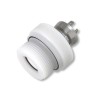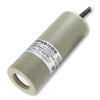Conductive sensing for detecting when a preset fluid level has been reached.
Conductive fluid level switches are threshold contact trip devices which typically consist of one or two metal rods extending out from the switch probe housing.
One of the metal rods has a custom length to reach the required fluid height.
The other metal rod extends down to a lower position, or alternatively the outer wall of a metal tank is used to complete the circuit.
When the fluid touches the custom length metal rod, the circuit is closed between the two electrodes.
Both electrodes are wired to an electrode controller module which maybe fitted within the probe housing or connected remotely. The controller will monitor the two electrodes and when the resistance changes, due to the fluid touching both electrodes, it will activate the switch contacts.
Additional fluid level switching thresholds can be achieved by incorporating more metals rods into the switch assembly, each one providing an additional level switching channel.
Glossary of Liquid Level technical terms
- Capacitive Fluid Level Measurement
- cmH2O – Centimetres of Water Column at 4 deg C Pressure Unit
- Float Fluid Level Detection
- ftH2O – Feet of Water Column at 4 deg C Pressure Unit
- mH2O – Metres of Water Gauge at 4 deg C Pressure Unit
- mmH2O – Millimetres of Water Column at 4 deg C Pressure Unit
- Specific Gravity
- Vibrating Tuning Fork Fluid Level Detection
Help from Liquid Level resources
- Difference between vented and non-vented water level measurement
- Measuring liquid level in a tank using a dp sensor
- Determining water tank volume using hydrostatic pressure
- Measuring the volume of liquid in a horizontal cylinder tank
- How do you measure the volume of a liquid using pressure
- Calculating required pressure range for fuel tank level measurement



